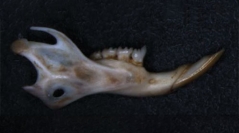

 Comptes Rendus Palevol
10 (5-6) - Pages 489-498
Comptes Rendus Palevol
10 (5-6) - Pages 489-498Though bone histology has become a powerful tool to reconstruct life history strategies and physiology in living and extinct reptiles and amphibians, it is of limited use in mammals. Dormice (Myoxidae) are good candidates for assessing the relation between bone microstructure and life history due to their long life span, marked physiological cycles and negligible bone remodelling. We carried out the most comprehensive study so far analyzing 16 wild individuals of unknown age belonging to two different species of dormice, Glis glis and Eliomys quercinus. Our study shows a high degree of consistency in the number of resting lines present in bones of the same individual, with femora providing the most accurate age estimations. Moreover, the presence of a single LAG in some juveniles allows discerning between offspring from different reproductive events (early or late litters).
Bone histology, Growth pattern, Life history, Bone tissue types, Skeletochronology, Conservation